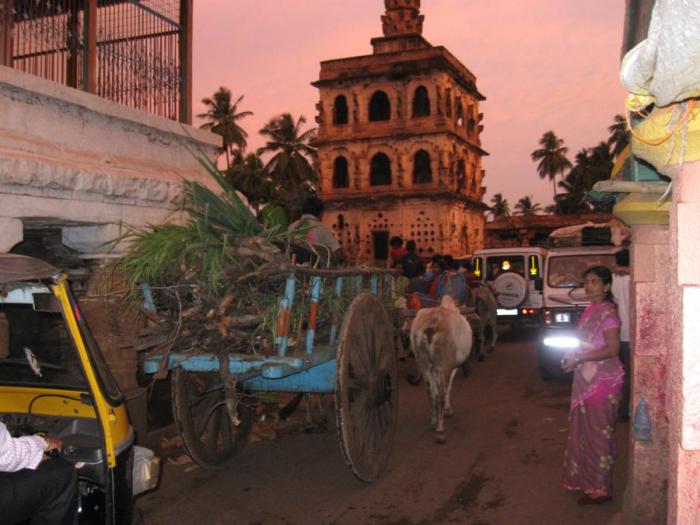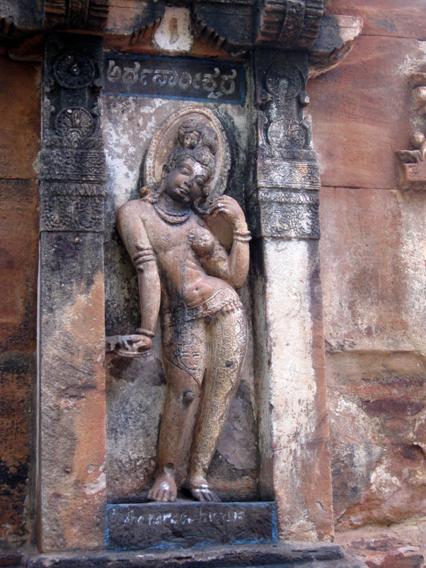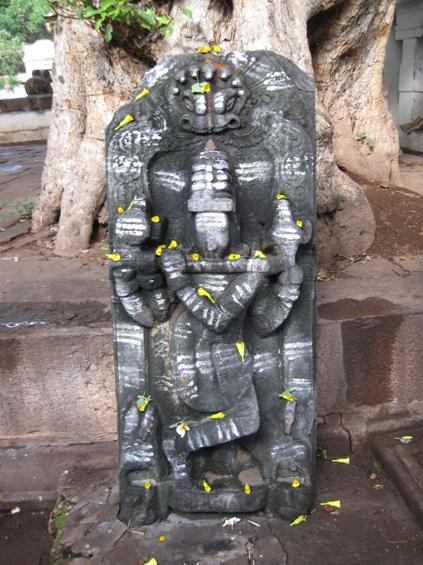My recent trip to some heritage sites in North Karnataka (Aihole, Badami, Bijapur, Hampi and Pattadakal) was an eye-opener in more ways than one. While I was amazed to see the excellent work done by the Archaeological Survey of India (ASI) in restoring and maintaining the sites, as well as the efforts taken by the Karnataka Tourism Board, I was appalled to see condition of heritage sites not maintained by the ASI. My visits to the Banashankari Temple and the Mahakuta Temple Complex, both near Badami, are perfect examples of this.
The Banashankari Temple site has been a place of worship for about 14 centuries or so, though the current temple building is only about 200 years old. The temple’s name is derived from its location in the Tilakaranya forest. The main deity, Banashankari is also known as Shakambari or the vegetable goddess. Banashankari was the kuldevata or the tutelary deity for the Chalukya kings of the 7th century.
Our tour group arrived at the Banashankari Temple after spending a magical and enchanted evening at the Bhoothnatha Temples and the Agastya Teertha, near the Badami Cave-Temples. And came back to earth rather rudely with a ride through narrow, dusty, potholed and dirty access road to the temple. It was an inkling to the state of the temple itself.

The Banashankari Temple is a smelly and dirty place. As we neared the garbha-griha or the sanctum sanctorum, the stench of fermented milk, coconut water, rotting flowers and banana leaves (all remnants of offerings to the deity) was overpowering. A quick pradakshina and I was out of the temple, breathing in relatively fresher air.
There is a beautiful, but dilapidated, water tank in front of the Temple. The Harida Teertha is enclosed by pillared and roofed corridors on all sides. At its entrance is a guard-cum-lamp tower. The whole ensemble made for a stunning backdrop against a golden sunset.

Our guide mentioned that Banashankari fulfilled the wishes of childless couples for a progeny. And once the child was born, the couple would come back to the temple and then walk through the waters of the Harida Teertha from one side to the other, floating the baby on a banana leaf. At my look of horror at the not too clean water of the Teertha, the guide assured me that the water was “not too deep, Madam. Only 3.5-4 feet deep. Very safe, Madam.”
The Banashankari Temple is the venue for a 3-week long jatre or fair every January, where thousands of people from all over Karnataka and the neighbouring state of Maharashtra gather. I shuddered to think what the crowds would be like during those days; it was bad enough and unmanageable on a September evening.

Our tour group visited the Mahakuta Temple Complex the day after our visit to the Banashankari Temple. It was 8 in the morning when we arrived and I was eager to erase my memories of the smelly and dirty Banashankari Temple. But that was not to be as the Mahakuta Temple Complex presented its own set of problems.

The Mahakuta Temple Complex is surrounded by magnificient banyan trees. Just seeing them, one could figure out that they were very old trees, perhaps 200-300 years old. At the entrance to the temple complex is a huge wooden chariot, with stone wheels, heavily carved and shiny with age. This cart is used for the annual rath yatra of the temple deity, Mahakuteshwara, a form of Shiva.
The temples in this complex date back to the 6th or 7th century and were constructed and patronised by the early Chalukyan kings. Like the Pattadakal Temples, the Mahakoota Temple Complex, too, has both the southern Dravidavimana as well as the northern Rekhanagara style of temples. The various temples in this complex are clustered around a beautiful water tank. Since there were many people bathing in the tank, I did not feel comfortable taking photographs of the tank.

The Mahakuta Temple Complex is full of lingams of various sizes, shapes and designs. One such unusual design is featured in the photograph on the right which has faces carved on the lingam.
According to our guide, “Mahakuta” means many lingams, thereby giving the temple its name. He claimed there there were a million lingams in the temple complex!
There are many carvings scattered around the temple complex and two of them, in particular, caught my attention: an Ardhanarishwara and a Krishna. The former has to be the most beautiful example of Ardhanarishwara that I have ever seen. And as for the latter, I actually checked and double checked that the idol was indeed that of Krishna. Who has ever heard of an ash-smeared Krishna as against a sandal-anointed one? See both the carvings for yourself.


All the temples in the complex are in various states of disrepair and was littered with paper, leftover food packets and plastic bags. Some of the temples also seemed to have people living in them. Perhaps, the temple priests? All in all, it was a depressing sight.

As I look back on the entire tour of the heritage sites of mentioned earlier, the visits to Banashankari and Mahakuta stand out and not just for the state that they are in. It is the contrast that they present against the monuments and sites maintained by the ASI. When both the Banashankari Temple (including the Harida Teertha) and the Mahakuta Temple Complex date back from the Chalukyan era, why are they not under the jurisdiction of the ASI? A possible answer to this question is that they are living temples. It is a rather weak answer; the Brihadeeshwara Temple at Thanjavur is a living temple, managed by the ASI, and is extremely well maintained.
The second question, and I think a disturbing one, is why are the Hindu temples so dirty? If Hindus can keep their puja corner/room in their homes clean, why can’t they treat their temples with the same respect and love and devotion?
P.S.: This visit was part of a tour organised by Doreen D’Sa of Doe’s Ecotours. She can be contacted at does_ecotours@yahoo.co.in.

Thanks Sudha jee for taking us through this journey.. have you read RK Narayanan’s ‘The Emerald Route’. They are his travelogues on Karnataka.. interesting.. and covers a lot of temples and mythology and history.
LikeLike
No, I haven’t read this one. This will be part of Christmas/New Year gifts for myself.
LikeLike
Sudha, this was my 4th visit to Mahakuta temple and I must point time that I had not seen the kind of litter that we saw this time. In fact, on my earlier visits, I came away with a feeling that this temple with its old trees was truly magnificent. Sad that littering our holy places has now become our culture.
LikeLike
Sudha jee
Very recently I had visited Badami, aihole and pattadkal. I regret I missed mahakuta group of temples due to heavy rain fall. you have given a nice picture of mahakuta and banashankari.
Thanks
LikeLike
These were some temples which really put me off . Indian culture cleanliness is next to godliness we have really forgotten.
LikeLike
I have visited so many temples. I dont like the way these purohits pouring milk,oil,ghee and all other stinky things on gods. people will also spoil the walls and sorrounding places. They have to do away with these all abhisheks.
LikeLike
Worship in a Hindu temple and abhisheks go hand in hand. I don’t see that being done away with. What is more important is the keeping the temple clean, which is where the problem lies, according to me. Have you seen a dustbin in a temple and the priests or anyone else for that matter sweeping the temple? Cleanliness does not equal Godliness in temples for sure.
Thanks, Shekhar for stopping by and commenting.
LikeLike
Yes Temples should keep clean. Some purohith’s do not bother about cleaning it. I see many clean temples in Mangalore & Udupi Districts. Good to visit sometime.
LikeLike
Welcome here, Shriya. Thank you so much for stopping by and commenting. I have visited temples in the Udipi and Mangalore regions and found them to be cleaner.
LikeLike